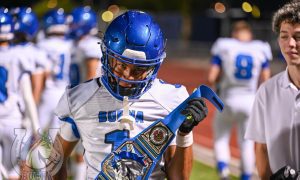[ezcol_1half id=”” class=”” style=””]

Fred Snowden’s high-scoring style of basketball drew sellout crowds at McKale Center immediately after transitioning from Bear Down Gym (ArizonaWildcats.com photo)
A snapshot of my childhood was staying after Arizona basketball games at McKale Center and watching Fred “The Fox” Snowden’s television postgame show courtside. When Snowden stepped off his makeshift set one night and waved me and my brothers over to the locker room to get autographs, my feet felt like they did not touch the ground for hours.
To this day, almost 40 years later, I’m kicking myself for misplacing that program signed by Herman Harris, Jim Rappis, Bob “Big Bird” Elliott, Al Fleming and Gilbert Miles to name a few.
Never heard of them? Elliott and former Arizona teammate Eric Money, both standouts who followed Snowden from Michigan, have published a book called “Tucson a Basketball Town” that will inform readers about these former standouts and more. They tell the stories about highly successful hoops existing on a national level before Lute Olson arrived in 1983.
[/ezcol_1half]
[ezcol_1half_end id=”” class=”” style=””]

A book about Arizona’s hoop history in the 1970s is available at the University of Arizona bookstore and Amazon.com.
[/ezcol_1half_end]
Olson told me in a 1996 interview with The Arizona Daily Star that he realized the potential of Arizona’s program when he noticed Snowden interviewed during the postgame television show following the Wildcats’ loss to his Iowa team in the 1975 Rainbow Classic in Honolulu.
“That showed me that Arizona had the elements of a big-time program under Fred,” Olson told me.
Olson will not be the only Hall of Famer in attendance tonight who understands Tucson’s roots as a basketball town. Bill Walton, who will serve as ESPN2’s broadcaster for the Cal-Arizona game at McKale Center, knows the success of Arizona’s program goes beyond Sean Miller and Olson.

Bob Elliott and his wife Beverely were shown during a recent Arizona basketball game in which he was lauded by ESPN commentator Bill Walton
Walton proclaims that Bob Elliott (not to be confused with Sean Elliott) and Snowden’s “Kiddie Korps”, as they were called, are at the backbone of Arizona’s success. Bob Elliott, one of only 107 collegians to tally at least 2,000 points and 1,000 rebounds in a career, helped Snowden put Arizona basketball on the national map in the 1970s after the coach came to Tucson following a stint as part of Johnny Orr’s staff at Michigan.
Arizona fans in their mid-30’s do not remember what the Arizona program was like before Olson. Children reaching their teen years know of Arizona’s four Final Four appearances and 1997 national championship only through YouTube and Google searches.
Those who are 40 and older know why Elliott and Money, one of Snowden’s original recruits from Detroit along with Coniel Norman, felt compelled to publish “Tucson a Basketball Town”. They collaborated on the book in an effort to “recognize an era of Arizona basketball that has not been recognized,” Elliott told me.
The book, which retails at $14.95, is available at the University of Arizona Bookstore and its satellite shops at Park Place Mall and Tucson Mall. Elliott and Money are at McKale Center this afternoon selling autographed copies of the book.

Former Arizona head coach Fred Snowden with Bob Elliott (left) and Herman Harris sitting behind him on the Arizona Basketball Media Guide cover of the 1976-77 team
It is also available to be ordered at Amazon.com.
Elliott, who proudly proclaims that he and Walton share a place in the CoSIDA Academic All-America Hall of Fame, told me this afternoon that he mailed Walton a copy of the book. Walton texted him back with a thank you message and acknowledged once again that “Big Bird” (Elliott’s nickname while at Arizona because of his 6-foot-10, 250-pound frame) was a significant reason why Arizona has evolved into a national power.
“Bill’s family and my family are pretty close,” said Elliott, who also owns an accounting firm in Tucson. “I really appreciate his support.”
“Tucson became a basketball town and Arizona became a basketball school when (late Arizona athletic director) Dave Strack hired Freddie Snowden to lead the program (in 1972),” Elliott continued. “You have to remember they were averaging only a couple hundred fans at Bear Down Gym before Freddie was hired.
“They moved across the street to McKale Center midway through the (1972-73) season. They sold out the place without any plans of a season-ticket program. Without Dave Strack that does not happen. There’s no Fred Snowden, no Eric Money or Coniel Norman. … The program would not be the same.”
In a 1990 article for the now-defunct Cat Tracks magazine, I was fortunate to interview Snowden about what his foundation for the program meant to Olson’s operations at the time.
“When I came to Arizona, I wanted to fill McKale Center with an exciting brand of up-tempo, pressure basketball,” said Snowden, who passed away from a heart attack four years after interview. “We felt that we would get the fans to come out and it worked.”

Eric Money, the co-author of “Tucson a Basketball Town”, was selected in the second round of the NBA draft by Detroit in 1974 (Inset: A current photo of Money)
Snowden, the first African-American to be hired as a Division I head coach, gave Tucsonans plenty to cheer about with entertaining players like Money and Norman and standouts such as Elliott, Fleming and Harris. The fan involvement included a couple of thousand people gathering at Tucson International Airport to greet the team after a significant road victory.
The zenith for Snowden was Arizona coming one game away from the Final Four in 1976, losing at UCLA 82-66 in the West Regional Final. The Bruins scored 12 consecutive points in the last eight minutes to break a 58-58 tie.
“The last five minutes … the last five minutes,” Elliott told me. “That’s what I think about. We were that close. It’s another part of Arizona basketball history not a lot of people know about.”
Elliott said the best part of putting the book together was the extensive research of Arizona basketball history. He and Money add to that history lesson with their experiences through anecdotes and pictures.
A couple of the photos include Snowden’s handwritten resignation as basketball coach and acceptance of a role within the Arizona athletic department in 1982. The program cover of Snowden’s funeral, the first to be held at McKale, is also displayed in the book.
Snowden, who would be 79 today, is “looking down with pride on a program of which he worked so hard to build,” Elliott told me.
“One of coach’s favorite sayings was, ‘Before you can run, you have to walk and before you can walk, you have to crawl.’ He was responsible for getting the program headed to where it is now.”
WILDABOUTAZCATS.net publisher, writer and editor Javier Morales is a former Arizona Press Club award winner. He also writes articles for Bleacher Report and Lindy’s College Sports.
[rps-paypal]
|
|
































